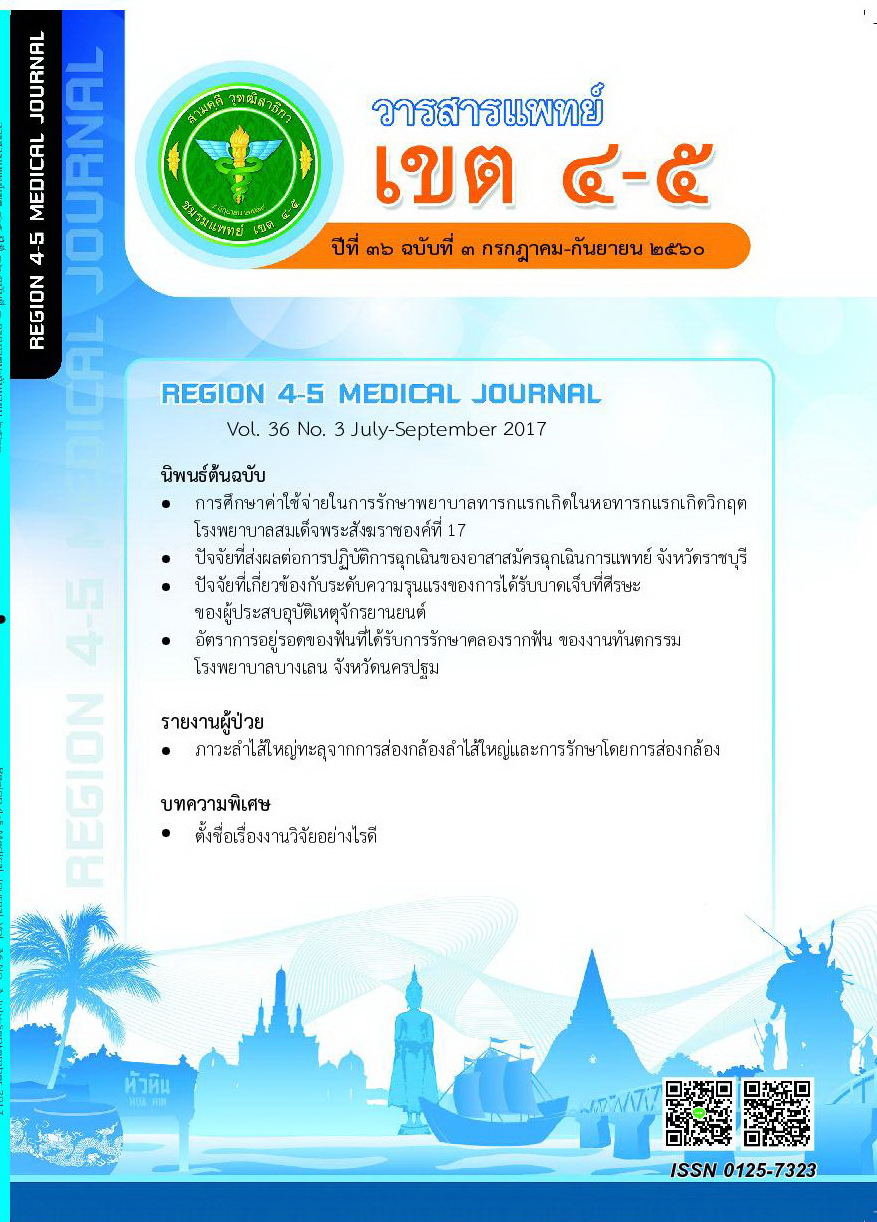ภาวะลำไส้ใหญ่ทะลุจากการส่องกล้องลำไส้ใหญ่และการรักษาโดยการส่องกล้อง
คำสำคัญ:
ภาวะลำไส้ใหญ่ทะลุ, การส่องกล้องลำไส้ใหญ่, การคลิปปิดรอยรั่วลำไส้ใหญ่บทคัดย่อ
ภาวะลำไส้ใหญ่ทะลุหลังการส่องกล้องลำไส้ใหญ่ เป็นภาวะที่พบได้ไม่บ่อยแต่มีความสำคัญเนื่องจากความรุนแรง มีได้ตั้งแต่ลำไส้อักเสบ เลือดออกจากลำไส้ ติดเชื้อในกระแสโลหิต จนกระทั่งเสียชีวิต อุบัติการณ์ลำไส้ใหญ่ ทะลุหลังการส่องกล้องพบได้ร้อยละ 0.3 ความเสี่ยงที่ทำให้เกิดลำไส้ใหญ่ทะลุมีดังนี้ การเตรียมลำไส้ก่อนส่องกล้องไม่ดีพอ การตัดติ่งเนื้อ การขยายลำไส้ส่วนที่ตีบ การใส่สเต้นท์ และประสบการณ์แพทย์ผู้ส่องกล้อง บทความนี้ได้รายงานผู้ป่วยได้รับการส่องกล้องลำไส้ใหญ่ เพื่อคัดกรองมะเร็งลำไส้ใหญ่ เนื่องจากมีอาการเจ็บ ท้องน้อยข้างซ้าย ตรวจพบเลือดในอุจจาระ ภายหลังจากรับยาปฏิชีวนะอาการดีขึ้นแล้ว ได้นัดมาส่องกล้องลำไส้ใหญ่ การส่องกล้องพบติ่งเนื้อที่ลำไส้ใหญ่ ได้ทำการตัดชิ้นเนื้อไปตรวจทางพยาธิ และมีภาวะลำไส้ทะลุ ซึ่งได้ทำการรักษา โดยใช้คลิปปิดรอยรั่วและเจาะระบายลมในช่องท้อง ผลการรักษาไม่พบภาวะแทรกซ้อน
เอกสารอ้างอิง
2. Raju GS, Saito Y, Matsuda T, et al. Endoscopic management of colonoscopic perforations (with videos). Gastrointest Endosc. 2011;74:1380-8.
3. Heldwein W, Dollhopf M, Rösch T, et al. The Munich Polypectomy Study (MUPS): prospective analysis of complications and risk factors in 4000 colonic snare polypectomies. Endoscopy. 2005;37:1116-22.
4. Chukamaitov A, Bradley CJ, Dahman B, et al. Association of polypectomy techniques, endoscopist volume, and facility type with colonoscopy complications. Gastrointest Endosc. 2013;77(3):436-46.
5. Rabeneck L, Paszat LF, Hilsden RJ, et al. Bleeding and perforation after outpatient colonoscopy and their risk factors in usual clinical practice. Gastroenterology. 2008;135;1899-1906.
6. Lieberman DA, Wuerker CK, Katon RM. Cardiopulmonary risk of esophagogastro duodenoscopy. Role of endoscope diameter and systemic sedation. Gastroenterology. 1985;88:468-72.
7. Choo WK, Subhani J. Complication rates of colonic polypectomy in relation to polyp
characteristics and techniques: a district hospital experience. J Interv Gastroentero. 2012;2(1):8-11.
8. Hassan C, Zullo A, De Francesco V, et al. Systemic review: endoscopic dilations in Crohn’s disease. Aliment Pharmacol Ther. 2007;26:1457-64.
9. Van Halsema EE, van Hooft JE, Small AJ, et al. Perforation in colorectal stenting:a meta-analysis and search for risk factors. Gasrtrointest Endosc. 2014;79:970-82.
10. Wang J, Zhang XH, Ge J, et al. Endoscopic submucosal dissection vs endoscopic mucosal resection for colorectal tumors: a meta-analysis. World J Gastroenterol. 2014;20:8282-7.
11. Riss S, Akan B, Mikola B, et al. CO2 insufflation during colonoscopy decreases post-intervention pain in deeply sedated patients: a randomized controlled trial. Wien Klin Wochenschr. 2009;121(13-14):464-8.
12. Leung CW, Kaltenbach T, Soetikno R, et al. Water immersion versus standard colonoscopy insertion technique : randomized trial shows promise for minimal sedation. Endoscopy. 2010;42:557-63.
13. Leung JW, Mann SK, Siao-Salera R, et al. A randomized, controlled comparison of warm water infusion in lieu of air insufflation versus air insufflations for aiding colonoscopy insertion in sedated patients undergoing colorectal cancer screening and surveillance. Gastrointest Endosc. 2009;70:505-10.
14. Iqbal CW, Cullinane DC, Schiller HJ, et al. Surgical management and outcomes of 165 colonoscopic perforations from single institution. Arch Surg. 2008;143:701-16.
ดาวน์โหลด
เผยแพร่แล้ว
รูปแบบการอ้างอิง
ฉบับ
ประเภทบทความ
สัญญาอนุญาต
ลิขสิทธิ์บทความเป็นของผู้เขียนบทความ แต่หากผลงานของท่านได้รับการพิจารณาตีพิมพ์ลงวารสารแพทย์เขต 4-5 จะคงไว้ซึ่งสิทธิ์ในการตีพิมพ์ครั้งแรกด้วยเหตุที่บทความจะปรากฎในวารสารที่เข้าถึงได้ จึงอนุญาตให้นำบทความในวารสารไปใช้ประโยชน์ได้ในเชิงวิชาการโดยจำเป็นต้องมีการอ้างอิงถึงชื่อวารสารอย่างถูกต้อง แต่ไม่อนุญาตให้นำไปใช้ในเชิงพาณิชย์




